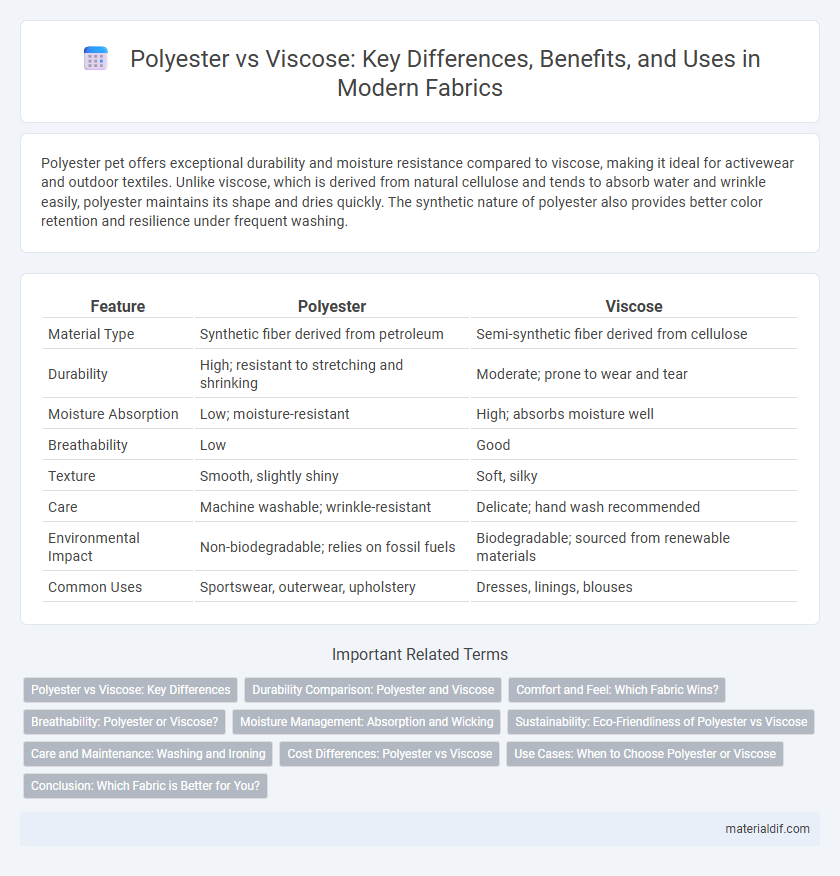Polyester pet offers exceptional durability and moisture resistance compared to viscose, making it ideal for activewear and outdoor textiles. Unlike viscose, which is derived from natural cellulose and tends to absorb water and wrinkle easily, polyester maintains its shape and dries quickly. The synthetic nature of polyester also provides better color retention and resilience under frequent washing.
Table of Comparison
| Feature | Polyester | Viscose |
|---|---|---|
| Material Type | Synthetic fiber derived from petroleum | Semi-synthetic fiber derived from cellulose |
| Durability | High; resistant to stretching and shrinking | Moderate; prone to wear and tear |
| Moisture Absorption | Low; moisture-resistant | High; absorbs moisture well |
| Breathability | Low | Good |
| Texture | Smooth, slightly shiny | Soft, silky |
| Care | Machine washable; wrinkle-resistant | Delicate; hand wash recommended |
| Environmental Impact | Non-biodegradable; relies on fossil fuels | Biodegradable; sourced from renewable materials |
| Common Uses | Sportswear, outerwear, upholstery | Dresses, linings, blouses |
Polyester vs Viscose: Key Differences
Polyester is a synthetic fiber known for its durability, wrinkle resistance, and moisture-wicking properties, making it ideal for activewear and outdoor clothing. Viscose, a semi-synthetic fiber derived from cellulose, offers a soft, breathable texture with excellent drape but lacks the moisture resistance and strength of polyester. The key differences lie in their origin, durability, moisture management, and environmental impact, with polyester being more resilient and viscose favored for comfort and biodegradability.
Durability Comparison: Polyester and Viscose
Polyester exhibits superior durability compared to viscose due to its synthetic fiber structure, which resists stretching, shrinking, and abrasion. Viscose, a semi-synthetic fiber derived from cellulose, tends to weaken when wet and is more prone to pilling and tearing over time. This makes polyester a preferred choice for applications requiring long-lasting fabric performance and resistance to wear.
Comfort and Feel: Which Fabric Wins?
Polyester offers durability and moisture-wicking properties but tends to feel less breathable and can trap heat compared to viscose, which is prized for its soft, smooth texture and excellent breathability that mimics natural fibers. Viscose provides superior comfort in warm climates and a luxurious, silky feel, making it a preferred choice for softness and coolness against the skin. Polyester excels in wrinkle resistance and longevity, yet viscose wins in comfort and tactile appeal for everyday wear.
Breathability: Polyester or Viscose?
Viscose offers superior breathability compared to polyester due to its natural cellulose fiber composition, enabling better moisture absorption and air circulation. Polyester, a synthetic fiber, tends to trap heat and moisture, making it less breathable and less comfortable in hot, humid conditions. Choosing viscose over polyester enhances comfort in warm climates by allowing the skin to stay cooler and drier.
Moisture Management: Absorption and Wicking
Polyester excels in moisture management through superior wicking properties, drawing sweat away from the skin and promoting rapid evaporation. Viscose, being more absorbent, retains moisture which can lead to a damp feeling during physical activity. This contrast makes polyester a preferred choice for activewear where quick-drying and moisture control are critical.
Sustainability: Eco-Friendliness of Polyester vs Viscose
Polyester is a synthetic fiber derived from petrochemicals, which raises concerns due to its non-biodegradability and reliance on fossil fuels, contributing to environmental pollution and microplastic release. Viscose, produced from natural cellulose fibers like wood pulp, offers better biodegradability but involves intensive chemical processing and deforestation issues that challenge its eco-friendliness. Sustainable alternatives in both fibers include recycled polyester and lyocell-based viscose, which aim to reduce environmental impact through resource efficiency and cleaner production methods.
Care and Maintenance: Washing and Ironing
Polyester fibers resist shrinking and wrinkles, making them easy to wash in cold or warm water and requiring low-temperature ironing to avoid melting. Viscose, a semi-synthetic fiber derived from cellulose, demands gentle hand washing or delicate machine cycles and low-heat ironing with a pressing cloth to prevent damage. Proper care prolongs polyester's durability and preserves viscose's soft texture, highlighting the need for tailored washing and ironing techniques for each fabric.
Cost Differences: Polyester vs Viscose
Polyester is generally more cost-effective than viscose due to its synthetic production process, which requires less raw material and energy compared to the cellulose-based manufacturing of viscose. The lower production costs of polyester contribute to its widespread use in affordable textiles and garments. Viscose, being semi-synthetic and derived from wood pulp, tends to have higher material and processing expenses, making it pricier in comparison to polyester fabrics.
Use Cases: When to Choose Polyester or Viscose
Polyester is ideal for activewear, outdoor gear, and upholstery due to its durability, moisture resistance, and wrinkle-free properties. Viscose excels in lightweight clothing, linings, and summer apparel because of its breathability, softness, and silk-like appearance. Choosing between polyester and viscose depends on the need for strength and easy care versus comfort and natural feel.
Conclusion: Which Fabric is Better for You?
Polyester offers superior durability, moisture resistance, and wrinkle retention, making it ideal for activewear and outerwear, while viscose provides a softer, more breathable feel suitable for lightweight clothing and warmer climates. Consider your lifestyle and climate needs: choose polyester for easy care and longevity, or viscose for comfort and natural drape. Understanding these fabric properties helps you select the best material for your specific wardrobe requirements.
Polyester vs Viscose Infographic

 materialdif.com
materialdif.com